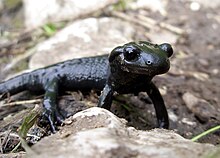Adelphophagy

The Adelphophagie (from Greek. Αδελφοί adelphoi = "siblings" and φάγος phagos = "eaters") refers to a form of diet by eating up of siblings.
Is deferred while the Cainism that occurs in different species of birds on the diet of often still in the uterus located pups by Nähreier or different embryonic stages of development, as it is found in a number of animal groups. In the former, the young animal killed by the siblings is usually not eaten directly, but it is often fed by the adult birds.
In direct adelphophagy, young animals are fed by their dams via fertilized eggs ( oophagy ) or embryos in various stages of development. This can lead to the formation of special feeding stages in the normal offspring, which are anatomically specially equipped for this diet. An example of this are the poison dart frogs of the genus Oophaga , whose tadpoles are fed by their mother's eggs. In many forms there is a typical arrest of the developmental stages provided for nutrition, which is probably determined by genetic control ( oocytic dimorphism before fertilization) or regulated by insemination by atypical sperm. This form of Adelphophagy occurs mainly in the hind gill snails , annelid worms or amphibians .
Others develop normal nutritional stages and develop a form of cannibalism such as uterine cannibalism , which occurs in sand tiger sharks , in which older juvenile sharks feed on younger embryos in the uterus after their yolk supply is depleted .
literature
- Keyword "Adelphophagie" in: Herder-Lexikon der Biologie. Spectrum Akademischer Verlag GmbH, Heidelberg 2003. ISBN 3-8274-0354-5
Web links
- Article from the ReefQuest Center for Shark Research on Adelphophagy in Various Shark Species (In English).